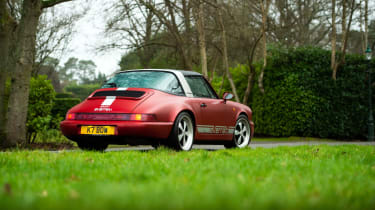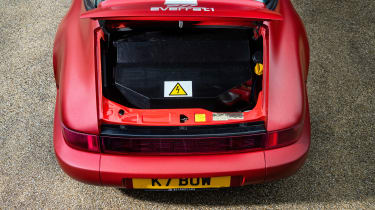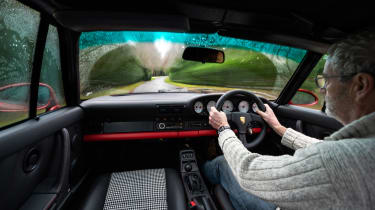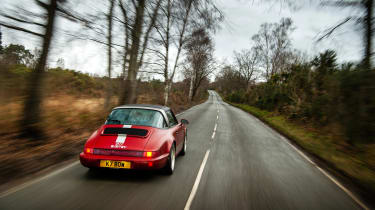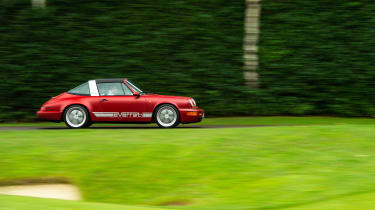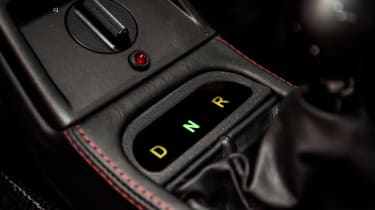Everrati Porsche 964 2021 review – a restomod 911 with a difference
It’s a ’90s 911, but not as we know it. Powered by a 440bhp electric motor, can this converted classic get close to the driving experience of the original?
It’s damp, cold and I’m in a Porsche 964 with a 440bhp motor in the back. Experience tells me that extreme caution will be required. I used to knock around in a 964 Turbo S in the late ’90s and that had 380bhp and was a bit of a beast, with some good old-fashioned lag thrown in and not much in the way of an electronic safety net.
That this car has an extra 60bhp is of concern, but the bigger issue is that it’s electric. I’ve driven almost all current EVs but never a classic car that has had an electrical transplant. We’ll get into the philosophy of electrifying classics, and indeed the morality of it, later on, but for now let’s concentrate on the car itself.
The company that has built it is called Everrati, behind which is successful businessman and car enthusiast Justin Lunny. Lunny made his fortune in something called fintech, and has spent some of it on a personal fleet that includes the dichotomy of a Taycan and a Mercedes G63. Heading Everrati’s engineering side is Mike Kerr, whose CV is formidable. Starting with Cosworth Racing, he moved through blue chip UK engineering and motorsport companies that include Xtrac and JCB, before going on to McLaren, where as drivetrains engineering manager he worked on the upcoming V6 hybrid powertrain, and then to Lotus, where he was link engineer between Lotus and Williams developing the Evija’s powertrain. Lunny has recruited wisely. Kerr gives the project a very high level of credibility, and it also helps that he is a long-time 964 owner himself, having bought his example when he was working in the DTM championship in Germany.
From the outside you’d never guess that this Targa was anything but standard unless you happened to notice that the exhaust tailpipe is missing. Why choose a Targa for this prototype? Lunny says that it was because one happened to be available, but I suspect purchase price might have come into it: no point in buying an RS or indeed a mint coupe. Like most existing classic car EV conversions it will be fairly straightforward to re-install the original engine and transmission at a later date if desired. Everrati will even supply you with a perspex case in which to display your flat-six and rest your Nescafé upon.
Kerr and his team set out with the goal of making the 964 feel very similar to drive as the ICE car, which means, particularly in a 911, getting the weight distribution correct. ‘We’ve managed to achieve a ratio of 40/60 front to rear, which is almost exactly the same as the standard car,’ explains Kerr.
Where Hans Mezger’s 3.6-litre engine used to live is a Large Drive Unit lifted from a Tesla Model S. However, Kerr and his team will be using a bespoke motor for production cars rather than sourcing second-hand Tesla components, the supply of which is never going to be predictable. ‘Our plan is to develop a platform or architecture that can be used in virtually any classic car,’ says Lunny, ‘which will reduce costs and make the conversion a lot more straightforward.’ Front, rear and four-wheel-drive powertrains will be available. Besides this 964 Targa, Everrati his been developing an electric Mercedes-Benz 280SL Pagoda and a Series II Land Rover. Also in development is a wide-bodied 964 with carbon wings and other weight-saving ploys.
The Tesla unit features two electric motors that bookend a single-speed transmission and differential. The standard diff is open, but Everrati has fitted a Quaife Torsen limited-slip differential, the effectiveness of which we will experience shortly. A 53kWh battery pack is installed, with a useable 50kWh, that contains 96 cells distributed between the front and rear of the car. Eighty per cent of the batteries are located in the engine bay, tight against the rear bulkhead, so although the overall weight distribution is the same as a regular 964’s, more of the weight at the back is ahead of the rear axle. At the front of the car are the remainder of the cells and the inverter, and the socket lives under the original fuel filler flap. Charging from 0 to 80 per cent takes about 45 minutes. Range from a full battery is 180 miles.
The one thing, apart from radically different weight distribution, that would wreck the feel of a 964 is how much weight there is. A standard 964 Carrera 2 weighs 1350kg, the Targa an extra 40kg. Kerr and his team have managed to add only 60kg to that figure for a total kerb weight of 1450kg (the same weight as a 964 Carrera 4, in fact).
It’s been a long time since I’ve sat in a 964; not since I drove that Turbo S. It’s all very recognisable, though. The Everrati Targa has white-faced dials that give rather different information to the usual array. Battery percentage replaces rpm, there’s another gauge for voltage that reads up to 400V, which is the car’s operating voltage, and lastly there’s a gauge for amps. Etched onto the dials is the work ‘Ionic’, which is what the company was called until Hyundai objected, saying it was too close to its own Ioniq. I suggested to Lunny that he could have done a Tim Dutton (who stood up to Ford after it challenged his use of Sierra and won in court) but Lunny says that it wouldn’t have been worth the hassle. Petty of Hyundai though.
A Porsche key in the standard ignition lock, twisted to the position in which once a starter motor would have begun turning, brings the 964 EV to life. There’s a very conventional-looking gearlever on the centre console with which you select D, N or R. It works through a dog-leg action and enables you to switch between forwards and backwards far quicker than you can with push buttons.
Within yards you can feel that the attention to getting the weight in the right place has paid off. The suspension has been tweaked to take into account different corner weights, and there are adjustable Konis all round. Speed up and there’s the trademark 911 front-end liveliness.
The brakes are standard, but because there’s no internal combustion engine and therefore no vacuum source, an electric vacuum pump has been installed. There’s no accessory drive to power a hydraulic pump for the power steering either, so In its place, at the front of the car, is an electrically driven pump. ‘It’s been a challenge,’ says Kerr, ‘to make sure that it can’t be heard from the cabin, because without a flat-six making a racket you can hear other things. We’ve fitted an accumulator to the brake vacuum pump so that it only runs when it’s needed.’
The Everrati 964 does 0-60mph in 4.5sec, which compares to around 5.1sec for a Carrera RS of the same vintage. Top speed has yet to be measured, but this car has run to 120mph. No doubt it will go a lot faster but anyone who has driven a 964 at over 150mph will tell you that it gets a bit scary up there.
Acceleration in electric vehicles can be quite bizarre. It’s the silence and lack of gearchanges plus the delivery of maximum torque from zero revs. This car has 339lb ft of torque and feels very fast but not quite as quick as the numbers might suggest. Traction is unbelievably good and we’re on damp roads to boot. Kerr swears that there’s no genius electronics at work, just the Quaife LSD and the Porsche’s retained weight bias.
Kerr and his team have a multitude of developments that are being worked on for the electric platform that will be used in future transformations. Synthetic noise generation is one of the more predictable, but another less obvious feature will be the creation of ‘artificial’ gearchanges. ‘You’ll have a normal H-pattern gear selection and as you move from one gear to the next there’ll be an interruption and manipulation of the torque to replicate the sensation of going up through the gears,’ explains Kerr.
I can see this making more of a difference to what an electrified classic feels like to drive than a fake engine noise, especially as I’ve yet to drive an EV with anything resembling a decent engine note: the Porsche Taycan’s selectable ‘engine noise’ sounds like it came out of the old BBC Radiophonic Workshop, while the Ford Mustang Mach-E generates, when the correct button is pressed, noise that sounds like a weedy V6 with a couple of pillows on top of it.
The productionised version of the Everrati 964 will cost you £250,000. It’ll have been restored to the last nut and will be perfect. I have no doubt that Everrati will find customers, and more still for the Pagoda SL, a car that I would imagine is absolutely perfect for electrification. There will be those who want to be sure of being able to drive their classics in cities (such as Paris) and others who want a classic that is more environmentally friendly, and an Everrati will meet that brief.
This electric 964 proves that the electrification of old stagers can work, too. The weight can be kept impressively low and you still have a narrow and manoeuvrable car that can be enjoyed on country roads. But… a couple of days after driving the Everrati I dropped by Moto Technique, the establishment responsible for the amazing restomod Ferrari 308 GTB driven in evo 278. They’d just finished another one, and peering into the back of it and seeing eight polished alloy intake trumpets was a sight to behold. And my God the noise the 3.8-litre V8 makes at 7500rpm is just amazing. And here, of course, is the problem: if you love engines, you’ll see them as an integral part of cars like these – their beating heart – and therefore an essential part of the experience.
The best solution for a fully authentic experience would therefore be renewable or E-fuels (see page 26), but until such fuels become widely available and accepted – assuming they ever do – the electrification of classics makes a lot of sense. Certainly a lot more sense than electrifying SUVs and ending up with inefficient two-and-a-half-ton monsters. L
| Motor | 298kW dual-motor drive unit |
| Power | 440bhp |
| Torque | 339lb ft |
| Weight | 1450kg (308bhp/ton) |
| 0-60mph | 4.5sec |
| Top speed | TBC |
| Price | c£250,000 |

